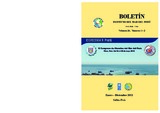Por favor, use este identificador para citar o enlazar este ítem:
https://hdl.handle.net/20.500.12958/2160Registro completo de metadatos
| Campo DC | Valor | Lengua/Idioma |
|---|---|---|
| dc.contributor.author | Ledesma Rivera, Jesús | |
| dc.contributor.author | Tam Málaga, Jorge | |
| dc.contributor.author | Graco, Michelle | |
| dc.contributor.author | León, Violeta | |
| dc.contributor.author | Flores Gonzáles, Georgina | |
| dc.contributor.author | Morón Antonio, Octavio | |
| dc.date.accessioned | 2013-07-05T21:54:41Z | |
| dc.date.available | 2013-07-05T21:54:41Z | |
| dc.date.issued | 2011 | |
| dc.identifier.citation | Bol Inst Mar Perú 26(1-2), 2011: p. 49-57 | es_ES |
| dc.identifier.issn | 0458 - 7766 | |
| dc.identifier.uri | https://hdl.handle.net/20.500.12958/2160 | |
| dc.description | Boletín IMARPE vol. 26, nº 1-2, 2011; p. 49-57 | |
| dc.description.abstract | Se analizaron datos de oxígeno disuelto, frente a las costas del Perú, para comprender las variaciones de la ZMO, caracterizadas por: a) el espesor de esa zona, limitada por las isolíneas de oxígeno de 0,5 mL.L-1; y b) la profundidad de su límite superior en la franja marino costera. Se muestran los resultados de las evaluaciones en la columna de agua, en la bahía de Callao en el periodo 1999 – 2009, y además en enero - febrero 2009 en un estudio de la ZMO, durante el Crucero Meteor 77-4 0901-02: Interacción en el Océano Tropical, Biogeoquímica y Clima. En la zona costera del Callao (12°S) se acentúa la hipoxia; la ZMO se ve restringida por la plataforma y su límite superior más superficial se ubicó a los 2,5 m de profundidad. A partir de la información obtenida en enero–febrero 2009 (Crucero 0901-02) se analizó la variabilidad espacial de la ZMO, en donde se halló un espesor de ~637,8 m, en la sección Punta Falsa (6°S). Se analizó la dinámica de la ZMO y su límite superior, debido al gran interés que ha tomado, por el posible incremento de su espesor, en el contexto de cambio climático, con grandes repercusiones sobre los recursos pesqueros. | es_ES |
| dc.description.abstract | ABSTRACT: Data were analyzed for dissolved oxygen, in front of the coast of Peru, to understand the variations of the OMZ, characterized by: a) the thickness of the area bounded by the oxygen isolines of 0.5 mL.L-1; and b) the depth of its upper limit in the marine coastal strip. We show the results of evaluations in the water column in the Bay of Callao during the period 1999 - 2009, and also in January-February 2009 in a study of the OMZ during Meteor Cruise 77-4 0901-02: Interaction in the Tropical Ocean, Biogeochemistry and Climate. In the marine coastal zone of Callao (12°S) hypoxia is accentuated, the OMZ is constrained by the platform and its upper surface is located more than 2.5 m deep. From the information obtained in January - February 2009 (Cruise 0901-02) examined the spatial variability of the OMZ, where a thickness of ~ 637.8 m was found in Punta Falsa section (6°S). We analyzed the dynamics of the OMZ and its upper limit, due to the great interest taken by the possible increase of its thickness in the context of climate change, with major impact on fisheries resources. | |
| dc.description.sponsorship | Proyecto GEF -PNUD - GEMCH | es_ES |
| dc.language.iso | spa | es_ES |
| dc.publisher | Instituto del Mar del Perú | es_ES |
| dc.relation.ispartofseries | Boletín;vol. 26(1-2) | |
| dc.rights | info:eu-repo/semantics/openAccess | |
| dc.rights.uri | https://creativecommons.org/licenses/by/4.0/ | |
| dc.source | Instituto del Mar del Perú - IMARPE | |
| dc.source.uri | Repositorio Digital IMARPE | |
| dc.subject | Corriente Humboldt | es_ES |
| dc.subject | Variabilidad | es_ES |
| dc.subject | Ecosistema | es_ES |
| dc.subject | Mar Peruano | es_ES |
| dc.subject | Oxígeno | es_ES |
| dc.title | Caracterización de la Zona de Mínimo de Oxígeno (ZMO) frente a la costa peruana entre 3°N y 14°S, 1999 - 2009 | es_ES |
| dc.title.alternative | Characterization of Oxygen Minimum Zone (OMZ) in front of Peruvian coast between 3°N and 14°S, 1999 - 2009 | es_ES |
| dc.type | info:eu-repo/semantics/article | es_ES |
| Aparece en las colecciones: | Boletín 26(1-2), 2011 | |
Ficheros en este ítem:
| Fichero | Descripción | Tamaño | Formato | |
|---|---|---|---|---|
| Bol. vol. 26-6.pdf | 1,87 MB | Adobe PDF |  Visualizar/Abrir |
Este ítem está sujeto a una licencia Creative Commons Licencia Creative Commons

